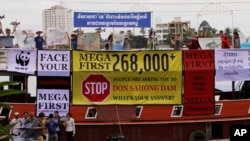Civil society groups are calling for Laos’ Don Sahong hydropower dam project to be discussed when Southeast Asian leaders meet with U.S. President Barack Obama next week.
Leaders of the 10 Association of Southeast Asian Nations member states will converge on the Sunnylands estate in California on Feb 15-16. The unprecedented U.S.-hosted summit comes amid increased efforts by the Obama administration to increase its security and economic presence in the region, where it wants to balance the influence of a rising China.
Environmental campaigners in Cambodia said the meeting would also provide a chance for countries of the region to appeal for American assistance or mediation on the awkward issue of hydropower on the Mekong river, the lower reaches of which have not yet been dammed.
This hope was expressed by nongovernmental organizations to U.S. Secretary of State John Kerry on his visit to Cambodia last month. Kerry’s itinerary on the trip also included Laos and China, two countries through which the Mekong runs before reaching Cambodia.
Of immediate concern for these groups is the plan to construct a 260-megawatt facility known as the Don Sahong dam at a site in southern Laos just 1.5 kilometers from the Cambodian border.
The governments of both Cambodia and Vietnam have raised concerns about the potential impacts downstream, where millions of people rely on the Mekong’s fish for protein.
Chhith Sam Ath, country director for the World Wildlife Fund in Cambodia, said that work on the dam should at least be suspended while Lower Mekong countries discuss the issue.
“Cambodia has Irrawaddy Dolphins in the Mekong, which may swim back and forth between Cambodia and Laos,” he told VOA Khmer. “It also is one of the countries in Asia that has the most fish. These fish contain protein that supports millions of people.”
As well as providing sustenance for many people, the undisturbed Mekong and the wildlife found in it bring in valuable tourism, he said, adding that all of this could be lost if a dam disrupts the river’s delicate ecosystem.
“We are worried that the Don Sahong dam will affect our efforts to protect dolphins, as well as about fish migration, water quality and the livelihoods of millions of people,” Sam Ath said.
“I hope the critical issue of the dam will be put on the table during the upcoming U.S.-Asean meeting,” he added. “This dam is the big issue that we need to talk about and carefully consider.”
As well as the proposed Don Sahong dam, Laos is already constructing the Xayaburi dam further north along the main stream of the Mekong river. Another 10 dams are also proposed by Laos, which has pushed ahead with hydropower projects despite opposition from the downstream countries.
Official protests have been lodged through the Mekong River Commission, a multilateral body formed out of a 1995 agreement between Laos, Thailand, Cambodia and Vietnam.
But another multilateral mechanism might hold more hope for an effective intervention over Laos’ hydropower plans.
The U.S.-funded Lower Mekong Initiative was created in 2009 after a meeting between then Secretary of State Hillary Clinton and the foreign ministers of Cambodia, Laos, Thailand and Vietnam. The initiative touts environment and water among its six “pillars,” through which it hopes to foster cooperation between the countries of the sub-region.
“We are working diligently to develop sustainable development practices on the Mekong River,” Kerry told reporters in Phnom Penh on Jan. 26. “And we have the Lower Mekong Initiative, which focuses on many of these issues and joining all of the countries together.”
According to the U.S. State Department, the initiative’s programs include the development of a tool to model the impacts of the climate change and other environmental challenges in the sub-region.
Tek Vannara, director of the NGO Forum on Cambodia, said that while about 60 million people rely directly on the Lower Mekong, some 300 million live in its periphery and should therefore be concerned about the potential impacts of a dam like Don Sahong.
He said the American government could, through the Lower Mekong Initiative, play an important role in creating an atmosphere in which the countries on the river can talk constructively about the dam.
“We want the program to focus on energy development and environmental protection,” he added.
“We want [the U.S.] to give us technical and financial support, or a mechanism to preserve the Mekong river, because protecting water resources well and using water with equity can guarantee food security in the Mekong region.”
Vannara said he was drafting a letter to Obama and the sub-region’s leaders, and other bodies, requesting that the Don Sahong project be on the agenda at Sunnylands.
Luy Rasmey, executive director of the Culture and Environment Preservation Association—based in Stung Treng, the Cambodian province opposite the Don Sahong dam site—told VOA Khmer that local communities’ concerns should be raised at the high-level meeting next week.
“[The dam] would have a lot of impact on the people who are relying on the river resource,” she said.









